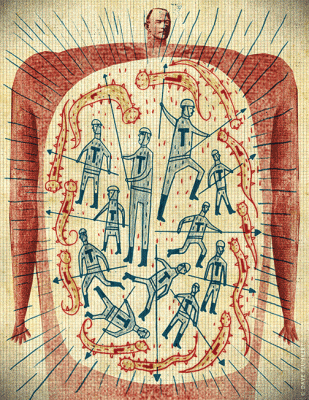
Four years after a tentative but tantalizing breakthrough against leukemia, Carl June and Bruce Levine C’84 have gone from the fringes of gene therapy to the center of a revolutionary approach to cancer treatment. But first they had to run out of money, conquer skeptics, and turn a 12-year exile from cancer research to their advantage.
BY TREY POPP
Illustration by Dave Plunkert
Photography by Candice diCarlo
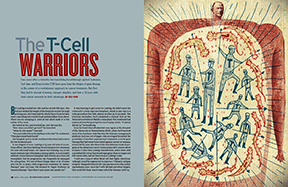
Bill Ludwig touched his wife and his mouth fell open. She had just walked the length of the hospital corridor through pouring rain. He’d watched the whole fiasco from his bed, water cascading onto Darla’s head and shoulders from above. There was no escaping it, until at last she’d made it to the safety of his room.
He looked at her, and touched her, and she was dry.
“How come you didn’t get wet?” he marveled.
“What do you mean?” she said.
“You just walked down the hallway in the rain!” he exclaimed. “The pipes must have burst!”
She laughed, and no doubt wondered what fate had in store for her husband next.
It was August of 2010. Ludwig, a 65-year-old retired corrections officer, had been battling chronic lymphocytic leukemia for nine and a half years. The cancer was winning. CLL is the most common type of leukemia among adults. It is incurable without a bone marrow transplant (also known as a stem cell transplant), but its progression can frequently be managed for a long time. “It’s one of those things where a lot of times you live for 10 years, with progressive resistance to chemotherapy,” says Carl June, the Richard W. Vague Professor in Immunotherapy. “And then it gets nasty and people die.”
It was starting to get nasty for Ludwig. He didn’t meet the criteria for a bone marrow transplant, which in any case is a risky procedure that fails almost as often as it succeeds. The previous December, he’d completed a clinical trial at the National Institutes of Health in Maryland. The treatment had weakened everything except for cancer’s grip on him. “It almost did me in,” he would say.
Soon he found himself admitted once again at the Hospital of the University of Pennsylvania (HUP), where he’d received most of his treatment. Only this time the leukemia-management playbook had run out of pages. His oncologist broached the possibility of another experimental treatment, a novel gene therapy that had never been tested against cancer in humans. A team led by June, who directs the translational research program at the Abramson Cancer Center, proposed to remove about a billion T-cells from Ludwig’s bloodstream, infect them with a modified HIV virus that would reprogram them to target and kill cancer cells, and let them loose in Ludwig’s body.
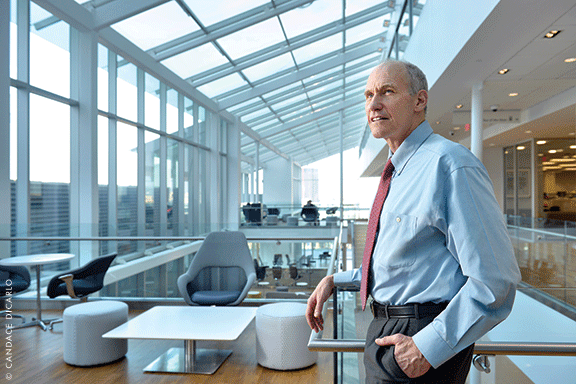
T-cells are a type of white blood cell that fights infections. Ludwig’s would be engineered to express a “chimeric antigen receptor” designed to bind to the CD19 protein on B-cells, including leukemic ones. Once the T-cells latched onto those targets, they could kill them. June’s team called the therapy CART-19.
The National Cancer Institute had declined to fund it, perhaps because a small handful of conceptually similar attempts elsewhere—against ovarian cancer, lymphoma, and neuroblastoma—had fizzled. But the Alliance for Cancer Gene Therapy, founded by Barbara and Edward Netter C’53, had stepped up to support a pilot trial.
“I was at my end,” Ludwig recalls. “I had for 10 years asked for strength from the Almighty, so to speak, to fight it. And I figured, well, there’s a clinical trial, I’ve got one fight left.”
Now he appeared to be losing it—in a rout. Ludwig, the first patient in the trial, had expected to be sent home to New Jersey several days after receiving the engineered T-cells. But on the day he was to be released from the hospital, chaos erupted.
“I developed fevers,” he recalls. “Hallucinations. My organs were shutting down. Lungs were going to pot. Heart wasn’t working right. Blood pressure was out of whack. Needless to say, I was a sick puppy dog.”
And a bewildered one. Sometimes, after eight good hours he’d cruise into bedtime on a wave of optimism. “I’m getting ready to go to sleep, and I haven’t had a fever all day, and I’m thinking, I’ve got this all beat. And at 2 o’clock in the morning it shoots back up. It just seemed like no one could put a handle on it.”
His condition whipsawed in the intensive-care unit until one evening the therapeutic team contacted Darla after she’d left for the day and told her to summon the family.
“I wasn’t going to see daylight,” Bill remembers. “All my kids, my children plus her, showed up late that evening.”
But he did see the next morning, and the one after that. A battle royale was indeed under way in his blood and his bones—but the CART-19 cells were winning. In fact they were winning so quickly that his body could barely handle the carnage. Subsequent analyses would show that these new “serial-killer T-cells” were replicating so profusely—the original billion cells multiplying to more than a trillion—and vanquishing B-cells so aggressively, that Ludwig’s body was effectively convulsing from the fallout of all that biological warfare.
Gradually, and with intense medical effort, his fevers abated. On the last day of August, according to Ludwig’s personal records, June’s team ordered a bone marrow biopsy. The way Bill understood it, the test was to determine whether the accumulation of dead white cells in his marrow was impeding the manufacture of new blood. A couple days later the clinicians returned to perform another one. Apparently the lab had gotten the first test mixed up.
In reality, the results of the first test were just too hard to believe. But the second test confirmed them: Ludwig’s leukemia was gone. Gone from his bone marrow, gone from his blood, gone from the lymph nodes that had recently been swollen with them. Two pounds of tumor, gone.
“I understood the words, They couldn’t find any cancer. But after 10 years, you err on the side of caution,” Ludwig says. “They never said I was cured. They said, ‘Currently you are cancer-free. We have no idea if it’s going to last a day, a week, a month, or a year.’”
Bill and Darla went home the day after Labor Day. After 10 years in which Bill’s only “vacation” from home had been in hospitals, they bought an RV. Four years later, they’re still driving it up and down the East Coast: to upper New York, Myrtle Beach, Florida in winter, Washington DC on Independence Day.
“I’ve taken my youngest grandson on three vacations I would not have done,” he reflected in December. “I now have three great-grandchildren I would not have seen born.” He was looking forward to the arrival of a 10th grandchild soon after the new year.
“Life,” he said, “has changed dramatically for me.”
After Ludwig’s stunning turnaround, June’s team treated two more patients. One, a 64-year-old man, also achieved a complete remission. The other, a 77-year-old man, had a partial response to the therapy. Then June’s team ran out of HIV vector and the money to make more, bringing production of engineered T-cells to a sudden and exasperating halt.
Surveying their options, they decided to try to publish the results. The annals of cancer research abound with encouraging small pilot trials that founder when extended to experimental groups large enough to generate statistically meaningful results. So this was something of a Hail Mary pass—but it worked. The New England Journal of Medicine and Science Translational Medicine published a pair of papers in August 2011. That didn’t change the tentative nature of the findings, but it was enough to reopen the funding faucet.
Since then, about 40 men and women with CLL have followed in the first three patients’ footsteps. More than 40 percent have responded to the treatment.
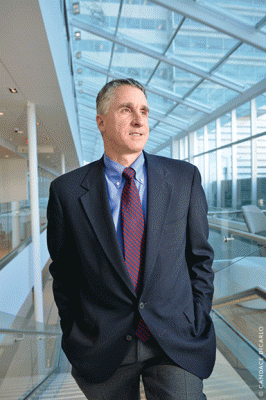
“These are patients who aren’t responding to anything,” says David Porter, the Jodi Fisher Horowitz Professor in Leukemia Care Excellence, director of blood and marrow transplantation at the Abramson Cancer Center, and the research team’s clinical leader. Their remissions have been “absolutely dramatic,” he adds. “We’ve had patients who have cleared over seven pounds of tumor. They happen rapidly. And they’ve been sustained.”
The proliferation and persistence of engineered T-cells in the body—an accomplishment that had eluded other researchers—appear to confer lasting protection against leukemia in responsive patients. In some cases partial remissions have converted into complete remissions over time.
“The beauty of T-cells is they last the rest of your life,” says June. “It’s a living drug.”
June is an angular 61-year-old with steely blue eyes and the headfirst gait and posture of a longtime cyclist. The first thing you notice when he opens his mouth is the attentiveness that preceded whatever he’s about to say. His voice has a gentle, husky quaver that resonates with emotion, and he speaks in unrushed, almost soothing cadences that belie the stubborn intensity that’s fueled his life in medical science.
“Right now, for most cancers, people aren’t cured,” he says. “And it’s an expensive, one-after-another revolving door of different therapies. So it’s not unusual, in many cancers, for people to pay a million dollars in healthcare costs, and yet they still die.”
And then there’s Bill Ludwig, popping into HUP every two months for an infusion of intravenous immunoglobulin—antibodies that make up for his dearth of B-cells, which his CART-19s are still primed to pick off.
“It’s an amazing story,” June says. “He gained 40 pounds back and decided to get an RV, instead of getting into the ground and dying. The guy’s now four years out.” In cancer, patients in remission for five years are often considered to be cured, though there is always a chance of recurrence.
“We’ve seen literally these Lazarus cases,” June continues, ticking through a mental list of patients as though still awestruck by their recoveries. “We’ll see how long [the remissions] last. But they were given death sentences before.”
Soon after trying the therapy against CLL, the group turned its attention to acute lymphoblastic leukemia (ALL), the most common pediatric cancer. They teamed up with Stephan Grupp, a pediatric oncologist at Children’s Hospital of Philadelphia. Most children with ALL respond to conventional chemotherapy, but the disease is fast and vicious for the roughly 10 percent who don’t. Despite therapeutic advances, it remains the leading cause of pediatric cancer mortality. (ALL is less common among adults, but more deadly.)
Chemotherapy also exacts a heavy cognitive toll on children who survive, even when radiation isn’t used. In 2009, Norwegian researchers found that ALL survivors treated exclusively with chemotherapy scored an average of 14 points lower than healthy peers on a standard IQ test.
June, who is generally an optimist, didn’t think his therapy would work as well against ALL.
“You don’t get a long time to treat it, and it progresses more rapidly” than CLL, he says. “We didn’t know if the immune system could catch up.”
But the results with ALL were even more dramatic. As of December 2014, 36 of the 39 children who had been treated had achieved complete remissions. More than two-thirds remained in remission at follow-up visits an average of six months later, including a 9-year-old who’d been the first patient in the study in the spring of 2012.
“These are patients with multiply relapsed refractory leukemia,” Porter stresses; each of them had failed multiple treatments, including bone marrow transplants in some cases. “Almost every patient will die of their leukemia within a few months without some effective treatment. And 90 percent of them clear their leukemia within a month.”
If the results prove durable—especially for this subset of patients with the worst possible prognosis—one could envision using the therapy (now known as CTL019) more widely, and earlier in the course of leukemia treatment. It could potentially save children from some of the cognitive damage of chemotherapy, or offer a safer alternative to bone marrow transplantation. If used on patients with lower tumor burdens, it’s possible that the side effects would be less dramatic.
The therapy is by no means risk-free, nor is it for the faint of heart. So far, all the patients who have responded have experienced the same harrowing symptoms that Bill Ludwig did. Some of these arise from tumor lysis syndrome—essentially, the body’s failure to cope with the toxic contents spilled by massive numbers of tumor cells dying all at once. Others are the result of what’s known as a “cytokine storm,” a feedback loop in which the immune system’s production of inflammatory and anti-inflammatory signals spins out of control. Both conditions are dangerous, but can be managed medically. Porter is working to develop a grading system to measure the severity of cytokine release syndrome and guide the timing of medications addressing it.
Whatever the case, patients now wait on pins and needles for their fevers to rise above 103 degrees. “They’re so anxious for it to happen,” says Heather Difillipo, who has cared for many patients in the trial as Porter’s nurse practitioner. “And we want it to happen,” she continues. “But you have to follow them so closely, because the floor can drop out from beneath them.”
Building trust, she adds, has been a crucial component in getting patients through the process. “Patients come here feeling desperate and scared. And many are relocating—they’ve been taken care of by another team they get so close with. So while they’re going through this critical phase, when they’re so sick, that’s the trust part of it, which is really challenging.”
Which makes it all the more exhilarating to see them come through, as though reborn without cancer.
“Most progress in medicine,” Porter reflects, “is through these incremental clinical trials—you make a little progress here and a little progress there. And when you look back over 10 years, you add up the incremental improvements, and you’ve made progress. But this is sort of a new branch on the evolutionary tree. Instead of just a little progress here and there, this is really a major leap in the way that I think we can approach at least certain kinds of cancer.”
If CTL019 is the therapeutic leap its creators increasingly believe it to be, they’ve been running toward the takeoff board for more than 20 years. Carl June’s road has been even longer.
In 1971, June was a high-school senior preparing to go to Stanford. The Vietnam War got in the way. Facing the prospect of conscription as an enlisted soldier, he opted to enroll in the US Naval Academy to become an officer instead. By graduation the war was over, so the Navy sent him to Baylor College of Medicine on a full scholarship, the last year of which he spent researching malaria vaccines at the World Health Organization in Switzerland.
Though he trained in oncology as a fellow at Seattle’s Fred Hutchinson Cancer Research Center—again on the Navy’s dime—June would spend the next 12 years effectively barred from cancer research. The Navy supports substantial research on infectious disease, but not cancer. So June found himself repaying his military obligation by conducting research on T-cells, which led to work on HIV. HIV spreads in the body by hijacking T-cells’ machinery to churn out more copies of itself before ultimately destroying them.
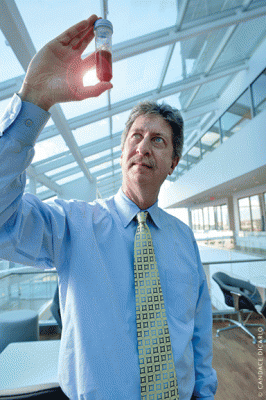
In the early 1990s he was joined by Bruce Levine C’84, who’d worked in a Wistar Institute lab as an undergraduate and was fresh off a PhD in immunology and infectious disease at Johns Hopkins.
Levine is a reflexively modest guy who keeps a poster-sized photomontage of Saturn and its moons on his office wall—a memento of the Voyager missions in the 1970s and 1980s. “I wanted to be an astronaut or astronomer, like most kids who grew up at that time, until I discovered how much math was involved in astronomy,” he says. “But I still like to look out beyond.”
He’s spent his career zeroing in on the cellular realm. First as a postdoctoral fellow and later as a full partner in June’s lab, Levine played an instrumental role in figuring out how to get T-cells to grow outside the body. Their big breakthrough involved coating microscopic magnetic beads with antibodies that bind with T-cell receptors, coaxing the cells to multiply with an efficiency no one had managed before. In its own way, the method is as elegant as using a planet’s gravitational force to slingshot a probe deep into space. Getting rid of the beads at the end is simply a matter of passing the T-cells over a magnet.
In the mid-1990s they infused laboratory-grown T-cells back into a small number of HIV patients, and showed that it could be done safely. Later they collaborated on the first trials using the HIV virus itself as a tool to modify T-cells in patients. In 1999 they came to Penn, where they continued this line of research, forging partnerships with a broad range of University researchers as well as several biotech companies that had developed or controlled useful gene-editing technologies.
It’s been a fruitful enterprise. In 2014, the New England Journal of Medicine published the results of their latest trial, which was inspired by the remarkable 2008 recovery from HIV of a man known as the “Berlin patient.”
Timothy Ray Brown, as his name was later revealed to be, was diagnosed with acute myeloid leukemia in 2006. His doctor in Germany arranged for a stem-cell transplant from a donor known to have a mutation in a gene called CCR5. The CCR5 gene encodes a T-cell receptor that many strains of HIV require in order to infect the cells. In people who carry this somewhat rare mutation, HIV rarely progresses to AIDS.
Three months after receiving the first of two stem-cell transplants from this donor, Brown found himself completely free of HIV. (A second transplant was performed after his leukemia relapsed, and appears to have vanquished his cancer.) Six years later, he is widely considered to be the first human cured of HIV.
June and Levine collaborated with Pablo Tebas, a professor of medicine and director of the AIDS Clinical Trials Unit at the Penn Center for AIDS Research, to infuse 12 HIV patients with T-cells they genetically engineered to mimic the CCR5 mutation that cured Brown in Berlin. More than a dozen other researchers from Penn, Albert Einstein College of Medicine, and Sangamo BioSciences were involved in the effort.
The engineered T-cells flourished in these patients, roughly tripling in the first week before progressively declining—but remaining above baseline level—over the next nine months. The treatment also appeared to decrease the viral load of some patients who suspended their normal antiretroviral therapy during the experiment. Though the small study was designed to test the method’s safety, “the tantalizing question,” as the authors of an accompanying NEJM editorial put it, “is whether it might actually have been partially effective.” Further trials involving more patients, and testing methods to extend the longevity of CCR5-modified T-cells in the body, may provide a more definitive answer.
The HIV work has also proved pivotal in setting the stage for the cancer breakthrough.
June began shifting his attention back toward cancer research near the end of his time in the Navy, only without funding. When he got to Penn, he hit the ground running—seeing “low-hanging fruit” on branches that many scientists were starting to regard as bare.
Other gene-therapy researchers were also tinkering with T-cells at the time. “But they’d all had their feet just in the cancer camp,” where mouse retroviruses had become the preferred vector for reprogramming cells, June explains. “And the murine leukemia virus that all the other cancer groups are using works for a while, but then it gets turned off.”
“HIV works better to maintain the expression of the gene you want, because it evolved in primates and humans,” he says. “So that experience turned out to be a critical part of our success.”
They whittled the HIV virus from about 10,000 base pairs of DNA to roughly 5,000, neutering its ability to cause disease. Then they added about 3,000 base pairs of DNA. Derived from a variety of sources—a sequence from a mouse B-cell, a few human genes stitched together in a novel way, and genetic code from a cow growth hormone, for starters—this material would work together to reprogram the T-cells.
Spearheaded by a postdoctoral fellow named Michael Milone, now an assistant professor of pathology and laboratory medicine at HUP, June’s lab tested one iteration after another in mice. Looking back, this was the unsung struggle. For all the talk of an evolutionary leap in cancer treatment, this is also a story about painstaking basic research: the trial and error, the stepwise improvement toward an uncertain outcome, the sheer amount of time it all takes.
And time, as June knows painfully well, is often in short supply. In 1996, his wife, Cynthia, was diagnosed with ovarian cancer. After five years of treatment, she died in 2001. Richard Carroll, who joined Penn’s faculty the same year as June and Levine and became a close member of their team, died of pancreatic cancer in 2010.
The success of CTL019 therapy since then has bred a redoubled sense of urgency in its creators, because cancer has shadowed them. June lost his father to lung cancer. Edward Netter, whose foundation funded the trial that transformed Bill Ludwig’s life, lost his own to pancreatic cancer the following February [“Obituaries,” July|Aug 2011].
In recent months they have pushed beyond leukemia into lymphoma and myeloma—two other B-cell cancers—as well as mesothelioma and pancreatic cancer. A pilot trial on glioblastoma, the most common and aggressive malignant brain tumor in humans, is set to begin. Levine says they have a promising target candidate for triple-negative breast cancer.
These involve new types of custom CAR cells—and represent new challenges. “It’s kind of like an operating system,” says June, “where the only thing different will be the antibody we want to target.”
Finding suitable targets, though, is hard. June calls B-cells a “dream target,” because people can live without them as long as they get supplementary immunoglobulins. So even though CTL019 cells kill normal ones along with cancerous ones, it’s okay. Moreover, the absence of B-cells may be one of the things allowing CTL019 cells to persist so long in patients’ bodies. Because his team used a mouse antibody to make the chimeric CD19 receptor, June expected patients to make human anti-mouse antibodies and reject the engineered cells, as has been the case in other studies. But the CTL019 cells seem to have created a niche for themselves by wiping out the very B-cells that would have rejected them.
Conquering other types of tumors will require identifying antigens, or perhaps combinations of antigens, that are unique to them.
The process is fraught with risk. In 2013, June’s lab reported the cases of two patients infused with T-cells engineered to target an antigen called MAGE-A3, which is a feature of many tumor types but is rare in normal tissue. One patient had stage IIIB melanoma; the other had advanced myeloma.
“In all of the bioinformatics, and in all of the in vitro studies, and in all of the animal studies,” Levine recalls, the target “looked clean. But what had not been appreciated is that, when you engineer the affinity of the T-cell receptor, some things might happen. And what was not observed was that there was cross-reactivity to a protein called titin—and that was not observed in these systems, but only in the patients.”
Titin is a giant protein that acts like a molecular spring to provide elasticity to muscle tissue. It’s all over the heart. The engineered T-cells swarmed it. Both patients developed cardiogenic shock and died within days. Just finding out what had gone wrong took a monumental scientific effort.
“That was tragic,” says June. Yet the search for better targets continues—as does the development of strategies to avert unanticipated off-target toxicity.
“One way is to use cells that have a so-called ‘kill switch’ in them,” he says. “So if it starts causing mischief and the toxicity is more than the benefit, then you can just kill the CAR cells by giving a drug that will make them die.
“Or you can put more than one CAR on the same T-cell,” he continues. “It may be that no unique target is there, but cancer cells have A, B, and C. And other cells in the body have A, but not B or C, for instance. Then you can wire the CAR cell so it can only attack where it sees all three. That is doable.”
It also shows how much remains to be done.
Last year, in a retrospective essay in the journal Human Gene Therapy, June reflected on the characteristics he has come to see as critical to the success of pioneers in his field. Along with multidisciplinary interests, he singled out two other qualities. The first he described as “a remarkable degree of stubbornness to persist in the face of repeated experimental failures, [and] to persist when the field was held in generally low regard by other fields of biomedical research.” The second was “an extraordinarily long attention span, which in most cases spans several decades of sustained effort.”
For June and his colleagues, that stubborn persistence is starting to morph into bold confidence.
In 2012, Penn formed an alliance with Novartis, the global pharmaceutical company, to accelerate research, development, and commercialization of CAR therapies. The company, which will have exclusive licensing rights to CTL019, is contributing $20 million toward the construction of the Center for Advanced Cellular Therapeutics, a 30,000-square-foot campus facility that is expected to double Penn’s capacity to investigate and treat patients with these techniques.
Novartis is also supporting a multi-center Phase II trial of CTL019, which in July won FDA designation as a “breakthrough therapy” for ALL, putting it on the fast track for agency evaluation and guidance. For June, scaling out the treatment from “boutique cancer centers” to the wider medical world is the next big step.
“It’s not a scientific problem anymore,” he says. “It’s an engineering problem.
“We have a system here we developed that’s never been optimized for cost,” he continues. “Everything’s been done in a scientific way. And engineers now need to work on that to make it cost-effective.”
The therapy is not expensive, at least as medical advances go. It depends on the dosage, but June estimates that growing and testing the T-cells for one patient costs roughly $20,000—which, as anyone who’s ever received a hospital bill knows, may not even be the most expensive line item. And bone marrow transplants, the only other potential cure for some of these cancers, can range from $250,000 to $1 million.
“Costs are a funny thing,” says Don Siegel M’87, who directs the transfusion medicine and therapeutic pathology division at HUP. “But if you actually compare the cost of doing this to the cost of conventional therapy, it’s cheaper.” Of course, commercialization requires a profit margin, and companies will charge as much as they can—a nebulous process in the US healthcare market—but CTL019 doesn’t appear to be intrinsically bank-busting.
“The bottleneck,” Siegel says, “is the time and care and nurturing that each of these products take—and at this point, the work in the lab is not a trivial entry-level type thing.
“When you try to think about how this could get scaled up, there may not be enough qualified people to work in all these labs,” he continues. “So basically, the answer is that there has to be automation.”
In their presentations, Levine and June often show slides contrasting the labor-intensive manufacture of Ford Model-Ts with modern robotic assembly lines.
“We’ve got the first-generation process now,” says Levine. “That’s going to evolve bit by bit into automated processes, until we have these arrays of manufacturing sites with devices where you put the cells in, and there’s software that drives the isolation and the culturing of the cells and the testing of the cells.” Technicians will be able to monitor the process digitally, he suggests. “And that will allow us to scale out.”
Siegel says manufacturers of apheresis machines—the devices that strip certain constituents from a patient’s bloodstream, like cholesterol or white blood cells—are already eying this opportunity.
In December he strolled through the apheresis unit he oversees at HUP, which is located a few steps away from the Clinical Cell and Vaccine Production Facility, a high-tech sterile environment where the T-cell magic happens. The machines whirred, each one whisking a patient’s blood cells through a closed system of disposable tubing, centrifuges, gears, and pumps. Bags hung from some of them, dripping serum albumin into the blood to replace the liquids being removed. Siegel talked about a company that’s developed a device to isolate, activate, and expand T-cells—the initial steps to engineering CARs.
“But there’s no reason,” he said, “why the whole thing couldn’t happen.” He mused about passing a patient’s blood through a machine that would produce a vial of cells at the end. That would be the treatment. It might even be a cure.
It’s not a new dream, but in the hallways of HUP and the Abramson Cancer Center, it’s starting to seem like a possible one.


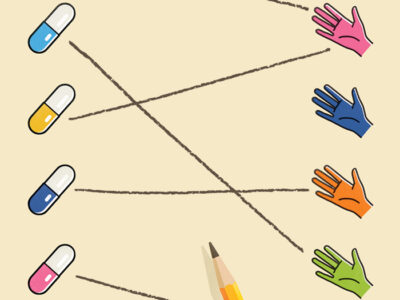
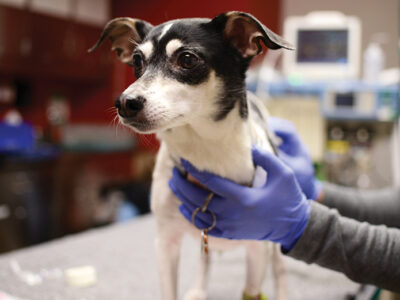
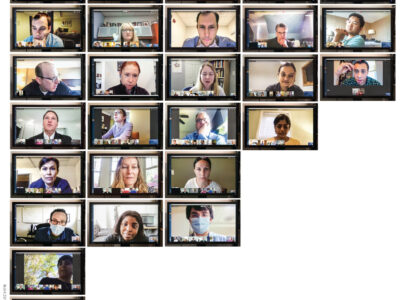
Informative article. This treatment just saved my life. I was released from Mass General two weeks ago. I had refractory diffuse large b-cell and probably had about a month left. I had nuerologixal side effects with seizures and a medically induced coma. I left the hospital after two weeks and walked out cancer-free. Large tumors just melted away. I am 37, and due to this procedure I get to be a mother to my four year old son. I can’t thank Dr.June and Dr. Levine enough, and all those who have come before me. My eyes swelled with tears many times upon reading this article, especially reading about those who did not make it through. The journalist was correct about the trusting your team too, I had absolute paranoid thoughts and delusions throughout but I knew my oncologist was a trusted face and knew he would be able to pull me through the very difficult reactions I had.
From one journalist to another: very well written article.
As a practicing Internist, thank you for the article. Today saw a patient whose wife has Stage 4 CLL and being treated here in San Diego. Am sending him the article for possibly
contacting your clinic. When I discussed the article with him, his eyes lit up with Hope.
I’m proud of my Alma Mater and your work. Keep it up!
I was completely overwhelmed with happiness while reading this. I do not know any of the patients but do know Mr. Bill and I have a very close mutual friend. I heard of his struggles and his beating cancer. I weeped with joy while reading this article and am overwhelmed with happiness to hear of the success of this procedure. Thank you all for all the hard work you put in to save the lives and give back happiness to these people who struggle with cancer.
Thank you for the informative article.